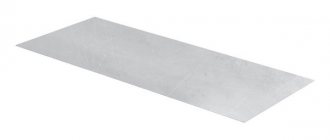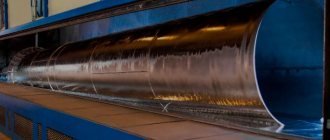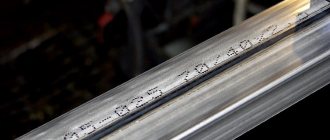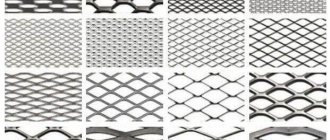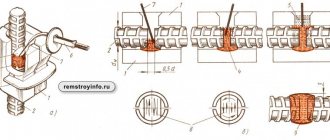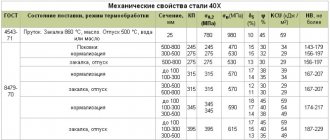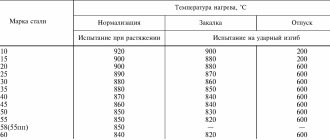GOST 5781-82 for download
M E F G O S U D A R S T V E N N Y S T A N D A R T
HOT-ROLLED STEEL FOR REINFORCEMENT OF REINFORCED CONCRETE STRUCTURES
Specifications
Hot-rolled steel for reinforcement of ferroconcrete structures. Specifications
This standard applies to hot-rolled round steel of smooth and periodic profiles intended for the reinforcement of ordinary and prestressed reinforced concrete structures (reinforcing steel).
Regarding the standards for the chemical composition of low-alloy steels, the standard also applies to ingots, blooms and billets.
Application area
The purpose of metal products is to reinforce reinforced concrete structures. Smooth rods are used to perform operations such as tying the working rods of a metal frame, forming decorative structures for landscape design, and installing individual components of complex mechanisms. Rods with a corrugated surface are used to strengthen products and structures made of concrete, installation of load-bearing elements and load-bearing structures, strengthening of layers of plaster and floor screed, strengthening of the coating in the process of laying the roadway, installation of armored belts when laying walls made of aerated concrete, foam concrete, and brick. Reinforcement within structures compensates for compression and fracture of the material by creating stress in the reinforcing bars.
Classification of fittings
Reinforcement can be classified according to the following main characteristics:
- According to production technology, hot-rolled (rod) and cold-rolled (wire) are distinguished. Moreover, depending on the diameter, the rod can be supplied both in rods and coils.
- According to the method of hardening, it is subjected to heat treatment or drawing.
- According to the shape of the profile, it is divided into corrugated (periodic profile) and smooth. The relief improves adhesion to concrete, so this rolled material is used for working reinforcement, that is, bearing the load. Smooth most often serves as a connecting element.
- According to the method of use during monolithic work, they are divided into non-tensioned, pre-tensioned and pre-tensioned.
Range
Smooth rods with a round cross-section and reinforcement with periodically corrugated surfaces are produced using hot rolling technology. According to their mechanical properties, metal products are divided into classes AI (A-240), A-II (A-300), A-III (A-400); A-IV (A-600), AV (A-800), A-VI (A-1000). The form of supply of reinforcing steel is rods (pieces) or coils. Rods of class AI (A-240) are produced with a smooth surface; reinforced steel of other classes is produced with a corrugated surface. According to an agreed specification, fittings of all classes can be manufactured with a smooth surface.
Table 1. Dimensions and weight.
| Profile No. (corresponds to the nominal D of the rods) | Transverse area rod cross-section, cm2 | Reference weight 1 m.p., kg | Max. off, % | Weight 1000 m.p., kg | Number of meters per ton |
| 6,0 | 0.28Z | 0,222 | +9,0 | 222 | 4 504,5 |
| 8,0 | 0.50Z | 0.395 | -7,0 | Z95 | 2 5З1.6 |
| 10,0 | 0,787 | 0,617 | +5,0 -6,0 | 617 | 1 620,7 |
| 12,0 | 1.1З1 | 0,888 | 888 | 1 126,1 | |
| 14,0 | 1,544 | 1,210 | 1210 | 826,44 | |
| 16,0 | 2.01Z | 1,580 | +Z,0 -5,0 | 1580 | 6Z2.91 |
| 18,0 | 2,541 | 2,000 | 2000 | 500,00 | |
| 20,0 | Z,14Z | 2,470 | 2470 | 404,85 | |
| 22,0 | Z,805 | 2,980 | 2980 | ZZ5.57 | |
| 25,0 | 4,917 | Z,850 | Z850 | 259,74 | |
| 28,0 | 6,169 | 4.8З0 | 48З0 | 207.0Z | |
| Z2.0 | 8,040 | 6,З10 | +Z,0 -4,0 | 6З10 | 158,47 |
| Z6.0 | 10,186 | 7,990 | 7990 | 125,15 | |
| 40,0 | 12,575 | 9,870 | 9870 | 101,Z1 | |
| 45,0 | 15,004 | 12,480 | 12480 | 80,12 | |
| 50,0 | 19.6ZZ | 15,410 | +2,0 -4,0 | 15410 | 64,89 |
| 55,0 | 2Z,762 | 18,650 | 18650 | 5Z,61 | |
| 60,0 | 28.27Z | 22,190 | 22190 | 45,06 | |
| 70,0 | Z8,484 | Z0.210 | Z0210 | ZZ,10 | |
| 80,0 | 50,275 | Z9,460 | Z9460 | 25,Z4 |
When calculating the mass of a steel rod, the density of steel is taken into account, equal to 7.85 × 103 kg/m3. Maximum deviations in diameter size are regulated by GOCT 2590-2006. The ovality of rods with a smooth surface cannot be greater than the sum of + and - maximum deviations in thickness.
Figure 1. Corrugation shape of hot-rolled rods of conventional design.
Figure 2. Corrugation shape of hot-rolled special-purpose rods.
Rods AI (A-240) and A-II (A-Z00) with a thickness of less than 12.0 mm and A-III (A-400) with a thickness of up to 10.0 mm are supplied in coils or sections, for larger thicknesses - in sections. Rolled products of classes A-IV (A-600), AV (A-800) and A-VI (A-1000) of all thicknesses are supplied in the form of pieces. Steel for reinforcement with a thickness of 6.0 and 8.0 mm, at the customer’s request, is sold in coils.
The standard length of the segments is from 6.0 to 12.0 m. In one batch, the presence of rods with a length of 3.0 to 6.0 m is allowed, provided that their number does not exceed seven percent of the total volume of the batch.
Table 2. Dimensions of rods in Fig. 1 (drawings a and b).
| Profile number, dn | d | h | d1 | h1 | t | b | b1 | r | ||
| Nomin. | Max. off | Nomin. | Max. off | |||||||
| 6,0 | 5,75 | +0,Z -0,5 | 0,50 | ±0,25 | 6,75 | 0,50 | 5,00 | 0,50 | 1,00 | 0,75 |
| 8,0 | 7,50 | 0.7Z | 9,00 | 0,75 | 5,00 | 0,75 | 1,25 | 1,10 | ||
| 10,0 | 9,З0 | 1,00 | 11,З0 | 1,00 | 7,00 | 1,00 | 1,50 | 1,50 | ||
| 12,0 | 11,00 | 1,25 | 1Z.50 | 1,25 | 2,00 | 1,90 | ||||
| 14,0 | 1Z.00 | 15,50 | 1,90 | |||||||
| 16,0 | 15,00 | 1,50 | 18,00 | 1,50 | 8,00 | 1,50 | 2,20 | |||
| 18,0 | 17,00 | ±0,5 | 20,00 | |||||||
| 20,0 | 19,00 | 22,00 | ||||||||
| 22,0 | 21,00 | +0,4 | 24,00 | |||||||
| 25,0 | 24,00 | -0,5 | 27,00 | |||||||
| 28,0 | 26,50 | +0,4 -0,7 | 2,00 | Z0.50 | 2,00 | 9,00 | 2,50 | Z.00 | ||
| Z2.0 | Z0.50 | Z4.50 | 10,00 | 2,00 | Z.00 | |||||
| Z6.0 | Z4.50 | 2,50 | ±0,7 | Z9.50 | 2,50 | 12,00 | Z.50 | |||
| 40,0 | Z8.50 | 4Z.50 | ||||||||
| 45,0 | 4Z.00 | Z.00 | 49,00 | Z.00 | 15,00 | 2,50 | Z.50 | 4,50 | ||
| 50,0 | 48,00 | 54,00 | ||||||||
| 55,0 | 5Z.00 | +0,4 | 59,00 | 4,00 | ||||||
| 60,0 | 68,00 | 1,0 | ±1,0 | 64,00 | 5,00 | |||||
| 70,0 | +0,5 | 74,00 | 4,50 | 5,50 | ||||||
| 80,0 | 77,50 | -1,1 | 8Z.50 | 4,60 | ||||||
Table 3. Dimensions of reinforcing steel Fig. 2 (drawings a and b).
| Profile number, nominal diameter dн | d | h | d1 | h1 | hr | hB | t | b | b1 | r1 | a, hail | ||
| Nom. | Max. off | Nom. | Max. off | ||||||||||
| 10,0 | 8,7 | +0,Z -0,5 | 1,6 | ±0,5 | 11,9 | 1,6 | 0,6 | 1,0 | 10 | 0,7 | 1,5 | 11 | 50 |
| 12,0 | 10,6 | 1,6 | 1З,8 | 1,6 | 0,6 | 1,0 | 10 | 0,7 | 2,0 | 11 | |||
| 14,0 | 12,5 | 2,0 | 16,5 | 2,0 | 0,8 | 1,2 | 12 | 1,0 | 2,0 | 12 | |||
| 16,0 | 14,2 | 2,5 | 19,2 | 2,5 | 1,0 | 1,5 | 12 | 1,0 | 2,0 | 12 | |||
| 18,0 | 10,2 | 2,5 | +0,65 -0,85 | 21,2 | 2,5 | 1,0 | 1,5 | 12 | 1,0 | 2,0 | 12 | ||
| 20,0 | 18,2 | 2,5 | 2Z,2 | 2,5 | 1,0 | 1,5 | 12 | 1,0 | 2,0 | 12 | |||
| 22,0 | 20, W | +0,4 -0,5 | 2,5 | 25, W | 2,5 | 1,0 | 1,5 | 12 | 1,0 | 2,0 | 12 | ||
| 25,0 | 2Z,Z | 2,5 | 28, W | 2,5 | 1,0 | 1,5 | 14 | 1,2 | 2,0 | 14 | |||
| 28,0 | 25.9 | Z.0 | Z1.9 | Z.0 | 1,2 | 1,8 | 14 | 1,2 | 2,5 | 14 | |||
| Z2.0 | 29,8 | +0,4 -0,7 | Z,2 | +1,0 -1,2 | Z6.2 | Z,2 | 1,2 | 2,0 | 16 | 1,5 | Z.0 | 14 | |
| Z6.0 | ZZ,7 | Z.5 | 40,7 | Z.5 | 1,5 | 2,0 | 18 | 1,5 | Z.0 | 19 | |||
| 40,0 | Z7.6 | Z.5 | 44,6 | Z.5 | 1,5 | 2,0 | 18 | 1,5 | Z.0 | 19 | |||
Table 4. Maximum length tolerances.
| L, m | Maximum length tolerances, mm | |
| normal cutting accuracy | increased cutting accuracy | |
| up to 6.0 m | +50,0 | +25,0 |
| from 6.0 to 12.0 m | +70,0 | +Z5.0 |
The maximum permissible curvature cannot exceed 0.6% of the total length.
An example of marking and its explanation:
● 20-A-II (AcЗ00) GOST 5781-82. This designates steel rods with a thickness of 20.0 mm of class A-II for special purposes.
Additionally, reinforcing steel can be designated by the following indices:
● C - easy to weld;
● T—heat-treated steel;
● K—corrosion-resistant steel (galvanized);
● CK - steel with high anti-corrosion properties, suitable for welding.
Technical requirements
2.1. Reinforcing steel is manufactured in accordance with the requirements of this standard according to technological regulations approved in the prescribed manner.
2.2. Reinforcing steel is made from carbon and low-alloy steel of the grades indicated in table. 5. The steel grade is indicated by the consumer in the order. If there is no indication, the steel grade is determined by the manufacturer. For class A-IV (A600) rods, steel grades are established by agreement between the manufacturer and the consumer.
Table 5
2.3. The chemical composition of reinforcing carbon steel must comply with GOST 380-88, low-alloy steel - with the standards given in table. 6
Table 6
In steel grade 32G2Rps, aluminum can be replaced with titanium or zirconium in equal units.
2.3.2. The mass fraction of nitrogen in steel grade 22Х2Г2АУ should be 0.015-0.030%, the mass fraction of residual nitrogen in steel grade 10GT should be no more than 0.008%.
2.3.3. The mass fraction of boron in steel grades 22Kh2G2R, 20Kh2G2SR and 32G2Rps should be 0.001-0.007%. In steel grade 22Х2Г2АУ, the addition of 0.001-0.008% boron is allowed.
2.3.4. It is allowed to add titanium to steel grades 18G2S, 25G2S, 35GS based on its mass fraction in finished rolled products of 0.01-0.03%, to steel grade 35GS based on its mass fraction in finished rolled products produced in coils of 0.01-0 .06%.
2.4. Deviations in the chemical composition in finished rolled products from carbon steels - according to GOST 380-88, from low-alloy steels, subject to compliance with the standards of mechanical properties - according to table. 7. Minus deviations in the content of elements (except for titanium and zirconium, and for the steel grade 20Kh2G2SR silicon) are not limited.
Table 7
2.5. Reinforcing steel of classes A-I (A240), A-II (A300), A-III (A400), A-IV (A600) is made hot-rolled, class A-V (A800) - with low-temperature tempering, class A-VI ( A1000) - with low-temperature tempering or thermomechanical treatment in the flow of a rolling mill.
It is allowed not to carry out low-temperature tempering of steel of classes A-V (A800) and A-VI (A1000) provided that a relative elongation of at least 9% and a uniform elongation of at least 2% are obtained when tested within 12 hours after rolling.
2.6. The mechanical properties of reinforcing steel must comply with the standards specified in table. 8.
For class A-II (A300) steel with a diameter over 40 mm, a reduction in elongation of 0.25% is allowed for each millimeter increase in diameter, but not more than 3%.
For steel class Ac-II (Ac300), a reduction in tensile strength to 426 MPa (43.5 kgf/mm) is allowed with a relative elongation of 30% or more.
For steel grade 25G2S class A-III (A400), it is allowed to reduce the tensile strength to 560 MPa (57 kgf/mm) with a yield strength of at least 405 MPa (41 kgf/mm), relative elongation of at least 20%.
Table 8
2.7. Statistical indicators of the mechanical properties of reinforcing steel bars of periodic profile must correspond to Appendix 1, with increased uniformity of mechanical properties - Appendix 1 and Table. 9.
The probability of achieving the mechanical properties indicated in table. 8, must be at least 0.95.
2.8. On the surface of the profile, including the surface of the ribs and protrusions, there should be no rolled cracks, stress cracks, flaws, rolled films or sunsets.
Minor damage to the ribs and protrusions is allowed, in the amount of no more than three per 1 m of length, as well as minor rust, individual rolled out stains, prints, sagging, traces of rolled out bubbles, rippling and scaliness within the permissible deviations in size.
2.9. The weldability of reinforcing steel of all grades, except 80C, is ensured by the chemical composition and manufacturing technology.
2.10. The carbon equivalent for welded rod reinforcement made of low-alloy steel of class A-III (A400) should be no more than 0.62.
Table 9
Acceptance rules
3.1. Reinforcing steel is accepted in batches consisting of profiles of the same diameter, one class of one melt-ladle and issued with one quality document. The batch weight should be up to 70 tons.
It is allowed to increase the mass of the batch to the mass of the melting ladle.
3. 2. Each batch is accompanied by a quality document in accordance with GOST 7566-81 with additional data:
- profile number;
- Class;
- minimum average value X and standard deviations S0 in a batch of values σT (σ0.2) and σB;
- results of cold bending tests;
- values of uniform elongation for steel class A - IV (A600), AV (800), A-VI (A1000).
3.3. To check the size and quality of the surface, select:
- in the manufacture of reinforcing steel in rods - at least 5% of the batch;
- when produced in skeins - two skeins from each batch.
3 4. To check the chemical composition, samples are taken according to GOST 7565-81.
The manufacturer determines the mass fraction of aluminum periodically, but at least once a quarter.
3.5. To test for tensile, bending and impact strength, two rods are selected from the batch
For a manufacturing enterprise, the interval for selecting rods must be at least half the time spent on rolling one profile size of one batch 3 6 If unsatisfactory test results are obtained for at least one of the indicators, repeated tests are carried out in accordance with GOST 7566-81.
